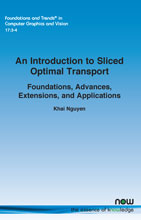An Introduction to Sliced Optimal Transport: Foundations, Advances, Extensions, and Applications
By Khai Nguyen, University of Texas at Austin, USA, khainb@utexas.edu
Abstract
Sliced Optimal Transport (SOT) is a rapidly developing branch of optimal transport (OT) that exploits the tractability of one-dimensional OT problems. By combining tools from OT, integral geometry, and computational statistics, SOT enables fast and scalable computation of distances, barycenters, and kernels for probability measures, while retaining rich geometric structure. This work provides a comprehensive review of SOT, covering its mathematical foundations, methodological advances, computational methods, and applications. We discuss key concepts of OT and one-dimensional OT, the role of tools from integral geometry such as Radon transform in projecting measures, and statistical techniques for estimating sliced distances. The work further explores recent methodological advances, including non-linear projections, improved Monte Carlo approximations, statistical estimation techniques for one-dimensional optimal transport, weighted slicing techniques, and transportation plan estimation methods. Variational problems, such as minimum sliced Wasserstein estimation, barycenters, gradient flows, kernel constructions, and embeddings are examined alongside extensions to unbalanced, partial, multi-marginal, and Gromov-Wasserstein settings. Applications span machine learning, statistics, computer graphics and computer visions, highlighting SOT’s versatility as a practical computational tool. This work will be of interest to researchers and practitioners in machine learning, data sciences, and computational disciplines seeking efficient alternatives to classical OT.
An Introduction to Sliced Optimal Transport: Foundations, Advances, Extensions, and Applications
Sliced Optimal Transport (SOT) is a rapidly developing branch of optimal transport (OT) that exploits the tractability of one-dimensional OT problems. By combining tools from OT, integral geometry, and computational statistics, SOT enables fast and scalable computation of distances, barycenters, and kernels for probability measures, while retaining rich geometric structure.
This monograph provides a comprehensive review of SOT, covering its mathematical foundations, methodological advances, computational methods, and applications. The key concepts of OT and one-dimensional OT are discussed, as well as the role of tools from integral geometry such as Radon transform in projecting measures, and statistical techniques for estimating sliced distances. The work further explores recent methodological advances, including non-linear projections, improved Monte Carlo approximations, statistical estimation techniques for one-dimensional optimal transport, weighted slicing techniques, and transportation plan estimation methods. Variational problems, such as minimum sliced Wasserstein estimation, barycenters, gradient flows, kernel constructions, and embeddings are examined alongside extensions to unbalanced, partial, multi-marginal, and Gromov-Wasserstein settings. Applications span machine learning, statistics, computer graphics and computer visions, highlighting SOT’s versatility as a practical computational tool.
This work will be of interest to researchers and practitioners in machine learning, data sciences, and computational disciplines seeking efficient alternatives to classical OT.
